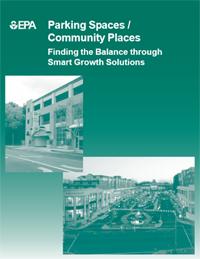Finding the Balance Through Smart Growth Solutions

What does parking have to do with the environment? Research from EPA and other entities shows that the way we develop our communities has a major impact on the quality of the natural environment. Regions with walkable, mixed-use, and compact neighborhoods, towns, and cities that are knit together by a robust network of transportation choices protect human health and the natural environment.
Parking policies and requirements can strongly influence a community’s built and natural environments. A better understanding of the influence of parking policies is an important step toward smarter growth.
The approaches described in Parking Places/Community Spaces (2006) can help communities explore new, flexible parking policies that can encourage growth and balance parking needs with other goals. This guide:
- Discusses the demand for and costs of parking.
- Demonstrates the significance of parking decisions in development patterns.
- Illustrates the environmental, financial, and social impacts of parking policies.
- Describes strategies for balancing parking with other community goals.
- Provides case studies of places that are successfully using these strategies to solve specific parking problems.
Many communities are reevaluating parking policies as part of a broader process of revisiting their goals for growth. Typical parking regulations and codes require a set amount of parking for a given square footage or number of units. These regulations commonly assume that all trips will be by private automobile. This assumption ignores a neighborhood's individual mix of uses, access to transit, walkability, and context within the region.
Inflexible parking requirements can force businesses to provide unneeded parking, wasting space and money while harming the environment. (EPA also helped develop a Trip Generation Tool for Mixed-Use Developments to help local government staff, consultants, and developers better estimate parking demand.)
The report includes a case study on the SAFECO Corporation that illustrates how parking policies can save money, improve the environment, and meet broader community goals. SAFECO offers employees a choice between transit, vanpool, and parking benefits. As a result, SAFECO’s 1,700 employees drive about 1.2 million fewer miles annually than the Seattle region commuting average, saving about 28 tons of carbon monoxide.
SAFECO also reduced the amount of ground that required paving by 100,000 square feet, leading to less runoff in this rainy region. The company saves an estimated $230,000 per year after accounting for the cost of incentives and savings from reduced parking construction.
Find more resources on smart growth and transportation.
You will need Adobe Reader to view some of the files on this page. See EPA’s About PDF page to learn more.- Parking Spaces/Community Places (PDF)(70 pp, 4 MB)
